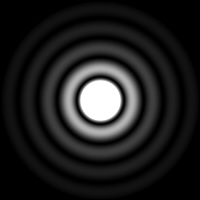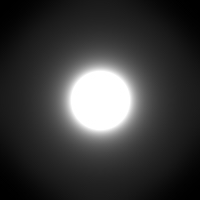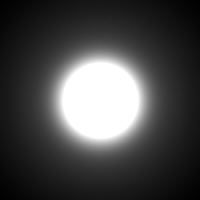Resolving Power
Resolution or resolving power is the smallest detail which is distinguishable in an image. The goal of most astro-imagers is that their images have the smallest details possible. Smaller resolution is better.
Some of the most important factors influencing the resolving power in astronomical images are:
- diffraction limit
- astronomical seeing
- optical aberrations, including focus
Only good focus is under your control, short of buying a larger aperture telescope or moving to a better observing location. During an imaging session, only better focus can help to achieve better resolving power.
Diffraction Limit

As described in the diffraction theory topic, light passing through an aperture causes interference patterns in the disturbed light waves. The diffraction pattern of a circular aperture disburses the light from a point source of light, such as a star, into a bull's-eye shaped image which is known as an Airy disk.
The Airy disk to the right is a simulated image of a point source of monochromatic (single-wavelength) light in the absence of blurring caused by astronomical seeing or any other effects. A gamma stretch has been applied to emphasize the otherwise very faint outer rings.
The size of the Airy disk is determined by the aperture of the telescope and is therefore fixed. For this reason, the size of the Airy disk is commonly used to define the diffraction limit of the telescope. The diffraction limits of telescopes are inversely proportional to telescope aperture, that is to say larger apertures have proportionately smaller diffraction limits.
The net effect of diffraction through a circular aperture is to spread a point source of light into a larger circular shape.
Astronomical Seeing

Astronomical seeing is the blurring and distorting effect of viewing astronomical objects through the Earth's atmosphere. Atmospheric seeing blurs the otherwise perfect Airy disk, usually to the extent that the individual rings of the Airy disk are no longer distinguishable.
In very short exposures, astronomical seeing causes speckling, which breaks the star image into separate, smaller speckles. Over longer exposures common to deep sky imaging, these speckles average out to a smoother, nearly circular blurring.
The simulated image at the right is a point source of visible light with circular aperture diffraction (Airy disk) and blurring caused by astronomical seeing. Notice how the central bright core of the image is larger than in the Airy disk image above due to the spreading effect of the astronomical seeing.
The net effect of astronomical seeing, on average in longer exposures, is to blur an image in a roughly circular and symmetrical way.
Optical Aberrations

Optical aberrations are the result of the less than perfect optical qualities of a telescope which further degrade an image beyond the effects of diffraction and astronomical seeing. Defocus, the opposite of focus, is often included in the analysis of optical aberrations, although it is not a fault in the quality of the telescope optics but instead is a fault in its adjustment.
The simulated image at the right shows a point source of visible light with circular aperture diffraction (Airy disk) and blurring caused by astronomical seeing plus further blurring caused by extremely poor focus. Notice how the central bright core of the image is larger than in the astronomical seeing image above due to the spreading effect of the defocus. Extremely poor focus is used here to illustrate the spreading effect because moderately poor focus can be nearly visually indistinguishable in an unobstructed star image.
The net effect of defocus is to blur an image in a circular and symmetrical way.
Net Effects
The effects of all three of diffraction, astronomical seeing, and defocus are to change a point source of light, such as a star, into a larger circular, blurred image. For an unobstructed image of a star (no diffraction mask), when focus is approaching a good quality, the effects of diffraction and astronomical seeing on a star image are larger than the effect of poor focus. The small effects of poor focus compared to the larger blurring effects of diffraction and astronomical seeing make it extremely difficult to use any unobstructed image of a star to assist in focusing or to rely upon subjective judgment for focusing.
The separate contributions to resolution are not directly additive, however the following is a representative summary:
| Factor | arc seconds |
| Diffraction Limit | 0.4 - 1.2 |
| Astronomical Seeing | 1.0 - 5.0 |
| Defocus | 0.0 - 0.5 |
| Total Resolution | 1.4 - 6.7 |
The above contributions to resolution are only intended to be representative. Individual experience will vary according to telescope aperture size, local and temporal astronomical seeing conditions, focuser quality, and focusing method. See the Resolution topic for a comparison of several common focusing techniques.
Defocus is the only factor subject to control (other than using a larger aperture telescope) and better focus is the only way to improve resolution during an imaging session.

